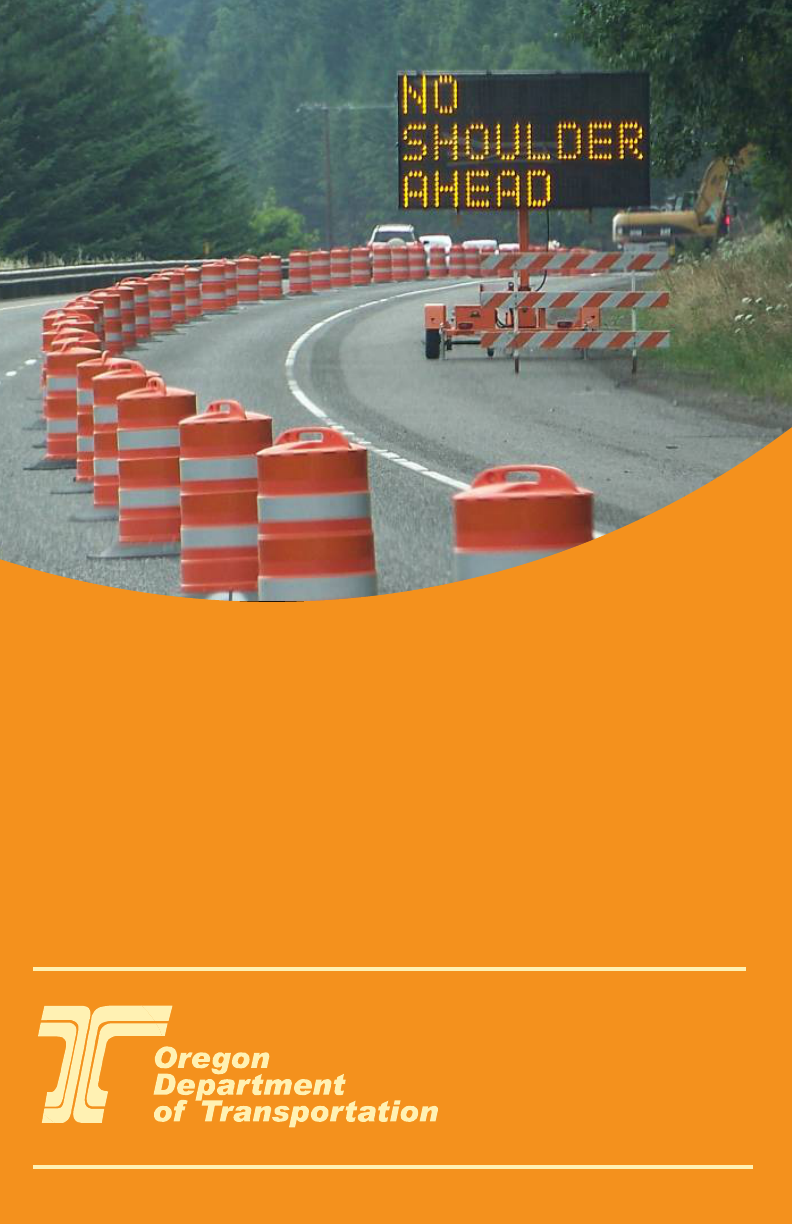
Portable Changeable
Message Sign Handbook
2nd Edition – September 2018
Technical Services Branch
Traffic-Roadway Section
Traffic Standards and
Asset Management Unit

Oregon PCMS Handbook Page i
September 2018 Title Page
Portable Changeable Message Sign Handbook
2
nd
Edition – August 2018
Justin King, P.E.
State Work Zone Engineer
Traffic Standards & Asset Management Unit
justin.s.king@odot.state.or.us
Sarah McCrea, P.E.
Work Zone Traffic Analyst
Traffic Standards & Asset Management Unit
sarah.a.mccrea@odot.state.or.us
Oregon Department of Transportation
Technical Services Branch
Traffic-Roadway Section
https://www.oregon.gov/ODOT/Engineering/Pages/Work-Zone.aspx
Oregon PCMS Handbook Page ii
September 2018 Table of Contents
TABLE OF CONTENTS
INTRODUCTION .................................................................................1
WHEN TO USE A PCMS .....................................................................2
EQUIPMENT ........................................................................................3
PLACEMENT........................................................................................5
Site Selection ............................................................................................... 5
Sight Distance & Visibility .......................................................................... 9
MESSAGES .........................................................................................10
Display ....................................................................................................... 10
Symbols and Graphics ............................................................................... 11
Message Content ........................................................................................ 11
Credibility .................................................................................................. 13
Standard Messages ..................................................................................... 15
Non-Standard Messages ............................................................................. 15
Message Exceptions ................................................................................... 19
Speeds ........................................................................................................ 20
Speed Detection Feature on PCMS ............................................................ 21
Locations and Distances............................................................................. 22
Times, Days and Dates............................................................................... 24
Security ...................................................................................................... 26
Standard Abbreviations .............................................................................. 26
REFERENCES ....................................................................................30
Oregon PCMS Handbook Page iii
September 2018 Table of Contents
APPENDIX A – STANDARDIZED MESSAGES .............................32
Advance Notification ................................................................................. 33
Detours and Road Closures ........................................................................ 34
Flagging and Traffic Signals ...................................................................... 35
Lane Closures or Traffic Pattern Changes ................................................. 36
Bridge or Tunnel Work .............................................................................. 37
Shoulder or Median Work.......................................................................... 38
Road Surface Conditions (Rough, debris, oil, fresh paint, etc.) ................. 39
Trucks ........................................................................................................ 40
Slow Moving Operations ........................................................................... 40
Motorcycles ................................................................................................ 41
Rolling Slowdowns .................................................................................... 41
Snow and Ice – Warnings .......................................................................... 41
Snow and Ice – Regulatory Conditions ...................................................... 42
Dust, Fog, Fire, or Smoke .......................................................................... 43
Crash, Stalled Vehicle, or Other Incidents ................................................. 44
Other General Warnings ............................................................................ 45
APPENDIX B – SETUP CHECKLIST ...............................................46
Need ........................................................................................................... 46
Placement ................................................................................................... 46
Message...................................................................................................... 46
PCMS MESSAGE WORKSHEET......................................................47
Oregon PCMS Handbook Page 1
September 2018 Introduction
INTRODUCTION
The purpose of this handbook is to provide basic information for the safe and
effective use of a Portable Changeable Message Sign (PCMS). This
handbook will illustrate proper setup and delineation for a PCMS, as well as
provide users with a variety of example messages for a broad range of
roadway activities.
A PCMS is a large electronic sign used to display programmable, dynamic
messages to provide traffic with timely warnings, guidance, or notification of
approaching roadway conditions.
Also known as a portable variable message sign (PVMS), this handbook may
be used in Oregon for roadway maintenance activities, incident management,
other short-term activities, and long-term construction projects on Oregon
roadways.
National and Oregon state standards, policies, and specifications that apply to
PCMS are found in the Manual on Uniform Traffic Control Devices
(MUTCD) [1], the Oregon Standard Specifications for Construction [2], the
Oregon Temporary Traffic Control Handbook (OTTCH) [3], and ODOT
Standard Drawing TM 800.
The contents of this handbook are based on guidance found in the following:
• Manual on Uniform Traffic Control Devices (MUTCD) [1]
• FHWA’s Portable Changeable Message Sign Handbook [4]
• Oregon Temporary Traffic Control Handbook (OTTCH) [3]
• Texas Transportation Institute’s (TTI) Development of a Field Guide
for Portable Changeable Message Sign Use in Work Zones [5]
Other available studies, guidelines, and research were also referenced in the
compilation of this handbook. A complete list of referred works is available
in the References section.
Oregon PCMS Handbook Page 2
September 2018 Introduction
WHEN TO USE A PCMS
A PCMS is a proven effective tool in a variety of temporary traffic control
conditions where modifications are made to the existing roadway
environment, traffic operations, traffic patterns, or other changes that strain
driver expectancy and demand increased driver attention, including where:
• Posted traffic speeds are reduced to enhance work zone safety.
• Normal traffic speeds are expected to drop substantially or
fluctuate regularly due to increased traffic congestion.
• Anticipated increases in traffic queuing and travel delays are
expected.
• Changes are made to roadway alignments or pavement surfaces.
• Advance notification for ramp, lane, or roadway closures is
needed.
• Lane usage changes (e.g. lane closures, turn lane closures, loss of
climbing/passing lane, etc.).
• A supplement to temporary signs or pavement markings would
enhance road user safety.
• Permanent signing has failed (e.g. sign structure failure, blocked
visibility, vandalism, etc.).
• A special event (e.g. sporting event, concert, parade, protest, etc.)
impacts normal traffic operation.
• Emergency situations or incident response create a need for
dynamic advance warnings or detour information.
•
Adverse weather or environmental conditions exist (e.g. dust,
smoke, fog, etc.).

Oregon PCMS Handbook Page 3
September 2018 Equipment
EQUIPMENT
PCMS are divided into three categories based on character height and the
number of message lines that can be displayed (See Table 1).
• Type A – Full Size PCMS
o Where posted speed > 45 MPH.
o May be used on low speed facilities where adequate space
allows for safe roadside placement.
• Type B – Mini PCMS
o Where posted speed < 45 MPH.
o May be used on high speed facilities in emergency situations.
• Type C – Truck-mounted PCMS
o Mounted on a work trucks (e.g. dump truck, 1-ton flat bed,
Incident Response vehicle, etc.); or,
o Other Equipment (e.g. roller compactor, motor grader, etc.)
Table 1 – PCMS Panel Display Requirements by Type
PCMS Type
Type A
Full Size
Type B
Mini
Type C
Truck-mounted
Min. Character
Height*
18 inches 12 inches 10 inches
Number of
Message Lines
per Character Height
3 lines @ 18 in.
3 lines @ 12 in.
2 lines @ 18 in.
2 lines @ 10 in.
Max. Number of
Characters per Line **
8 Characters
* Character heights less than 18 inches, or more than 3 lines shall not be used on Full Size
PCMS.
** Characters shall have a height-to-width ration of 1.4:1 (e.g. 5x7 character matrix.)
For mobile operations, a series of truck-mounted PCMS may be used to
display warning messages, or be set to “Caution” mode. Truck-mounted
PCMS are recommended for mobile operations for all roads [3].
NOTE: Use of vehicle-mounted flashing warning lights placed in front, or in
the line of sight of the PCMS can affect the legibility of the PCMS message
and blind drivers – particularly at night. Consider turning off flashing
warning lights mounted between the PCMS and approaching traffic.
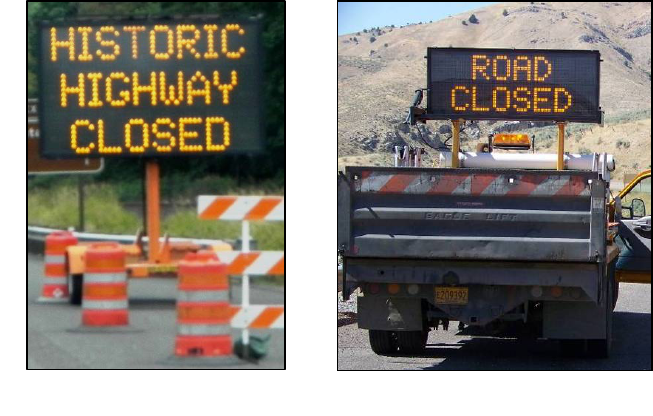
Oregon PCMS Handbook Page 4
September 2018 Equipment
Operate the PCMS according to the manufacturer’s instructions, the
temporary traffic control plan, and the project specifications, where
applicable.
For work activities on Oregon highways, use a PCMS listed on ODOT’s
Qualified Products List (QPL). The ODOT fleet procurement process
addresses specific needs for ODOT purchases.
Trailer Mounted PCMS Truck Mounted PCMS

Oregon PCMS Handbook Page 5
September 2018 Placement
PLACEMENT
Locate and align the PCMS to provide maximum legibility and time for
public traffic to interpret and respond appropriately to the message.
Site Selection
Locate a suitable site for the PCMS and adjust for road conditions as follows:
1. Straight, flat, level sections of roadway where practical.
2. Site should be safely accessible by maintenance/towing vehicle.
3. PCMS unit should be visible from ½ mile in day and nighttime
conditions.
4. PCMS message using 18 inch characters should be legible from 600
feet (min.) at night and 800 feet (min.) during daylight conditions.
5. Mini or Truck-mounted PCMS should be legible from 650 ft (min.)
under daylight or nighttime conditions.
PCMS located near a pullout for accessibility
6. PCMS unit shall be located behind a traffic barrier or delineated
using the PCMS Installation Detail on ODOT Standard Drawing TM
800, or as shown in the OTTCH [3], Chapter 4.
Delineated PCMS using TM800 detail
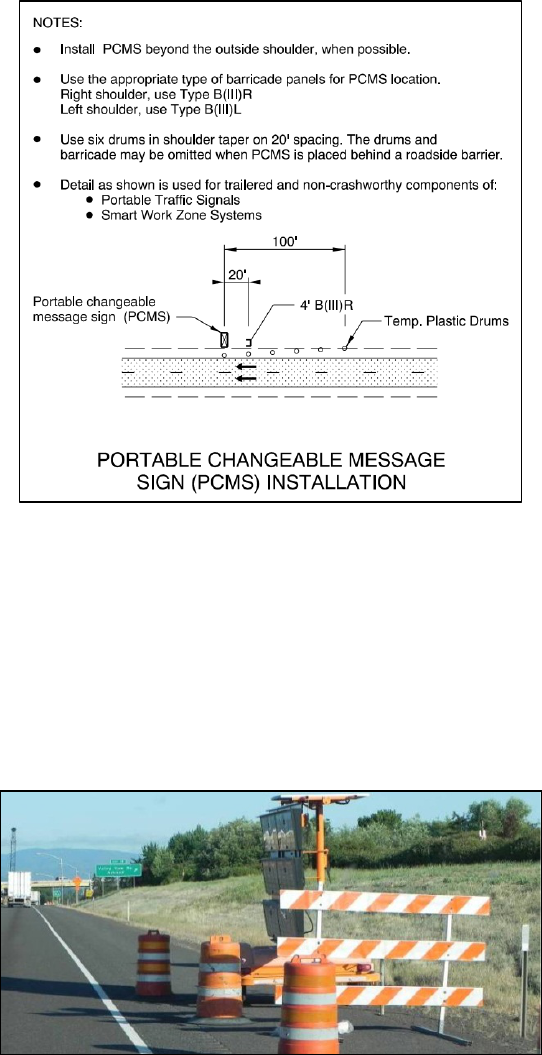
Oregon PCMS Handbook Page 6
September 2018 Placement
TM800 PCMS installation detail
7. When not displaying messages, the PCMS should be turned off and
the panel should be rotated away from traffic. When practical, and if
not being used for a long period of time (e.g. more than 24 hours),
PCMS should be moved behind a traffic barrier or to a location that
minimizes exposure to live traffic.
8. If relocating or shielding the PCMS behind a traffic barrier is not
practical, turn the PCMS panel away from traffic and delineate
using the PCMS Installation Detail on ODOT Standard Drawing
TM800, or as shown in the OTTCH [3], Chapter 4.
PCMS Lowered and Turned Away from Traffic

Oregon PCMS Handbook Page 7
September 2018 Placement
9. For detours, locate PCMS far enough in advance of route decision
points to allow road users to perform necessary lane changes or turns
to access the alternate route.
10. PCMS should be located away from existing or temporary
regulatory, guide, warning or other critical signs according to Table
2, below:
Table 2 – PCMS Spacing Table
Roadway Type
Posted Speed (mph)
Spacing (ft)*
Freeways
≥ 55
1000
Non-Freeway,
Rural Highway
≥ 60 700
Non-Freeway,
High-Speed
45 – 55 500
Urban Arterials
30 – 40
350
Urban, Low-Speed
< 30
100
* Consider increased spacing on multi-lane roads.
11. Locate PCMS away from high driver workload areas (e.g. busy
intersections, ramps, freeway decision points, etc. [6]). If ideal sites
are limited, place PCMS as far into driver’s cone of vision, as
practical, to optimize visibility of the messages.
High driver workload areas can affect PCMS visibility
PCMS too far beyond driver’s cone of vision
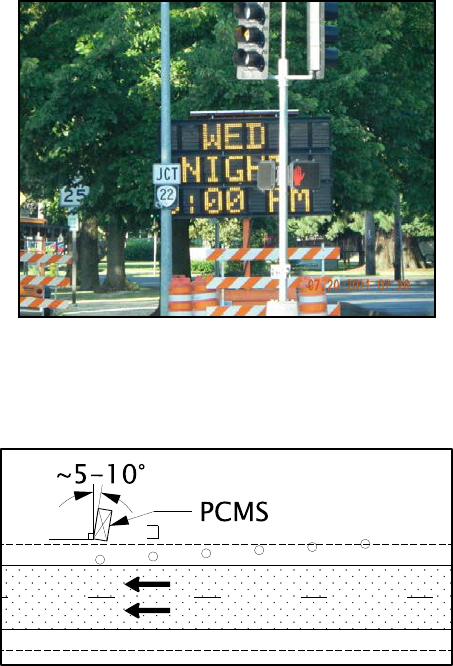
Oregon PCMS Handbook Page 8
September 2018 Placement
12. When multiple PCMS are needed, place them on the same side of the
roadway, and separate them by a minimum distance of:
• 1,000 feet on freeways and expressways
• 500 feet on all other roadways
Do not install temporary signing between the two PCMS to preserve
the integrity of the complex message sequence.
See Message Exceptions section, for additional guidance in using
two PCMS.
13. When possible, place PCMS to minimize visual clutter, and to avoid
other roadside features affecting PCMS messages.
On multi-lane roads with sufficient median width, PCMS may be
placed in the median for additional visibility.
Roadside clutter affecting message
14. Place PCMS on level ground, where practical. Use leveling jacks to
plumb the PCMS. Rotate PCMS panel face 5-10 degrees toward the
roadway to improve legibility [7].
Rotate sign to improve legibility
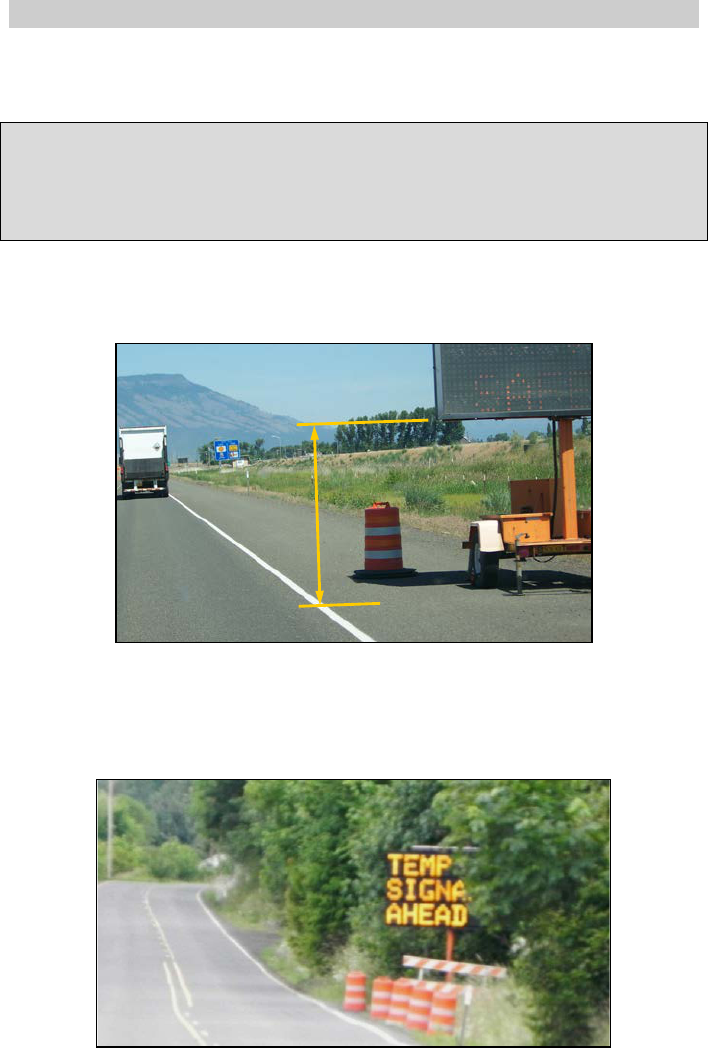
Oregon PCMS Handbook Page 9
September 2018 Placement
Sight Distance & Visibility
Horizontal and vertical curves, foliage, buildings, or other roadside features
may hide a PCMS. The PCMS may need to be located further from the
decision point to give motorists enough time to read the messages.
NOTE: PCMS message using 18 inch characters should be legible from 600
feet (min.) at night and 800 feet (min.) during daylight conditions.
Mini or Truck-mounted PCMS should be legible from 650 ft (min.) under
daylight or nighttime conditions.
When displaying messages, the bottom of the panel shall be a minimum of 7
feet above the roadway in urban areas, and 5 feet above the roadway in rural
areas, measured at the edge of the nearest traffic lane.
Proper height provides maximum message visibility
After the PCMS has been positioned, with the panel at the proper height and
rotated to face traffic, verify the PCMS is unobstructed and the messages can
be read from the distances shown above.
Field verify PCMS visibility after installation
7 ft min

Oregon PCMS Handbook Page 10
September 2018 Messages
MESSAGES
The primary purpose of a PCMS is to provide traffic with timely information
to facilitate safe movement through the area or work zone.
Display
A complete PCMS “Message” is made of two individual, alternating
messages. Each individual message is known as a “Phase” or “Panel”.
Each phase should be displayed for at least 2 seconds. Complex phases may
take longer to process and understand [6]. The total display time for both
phases should be no greater than 8 seconds.
Drivers traveling at the posted speed should be able to read the entire
message at least twice – allowing time to read the message, process it, and
take an appropriate action.
A PCMS message shall conform to the following:
• A maximum of 3 lines per phase.
• A maximum of 8 characters per line.
• A maximum of 2 phases (panels) per complete message unless stated
otherwise in Message Exceptions.
In developing a message for a PCMS, use the following best practices:
• Each phase contains an independent piece of information and can be
understood on its own.
• Use all upper-case letters, and center justify each line.
• If using only one phase, display the phase continuously. Avoid
flashing the same phase repeatedly.
• Do not use animation, rapid flashing, dissolving, exploding,
horizontal or vertical scrolling, or other techniques for displaying
phases.
• Requirements for character heights and number of message lines can
be found in Table 1.
• Characters shall have a height-to-width ration of 1.4:1 (e.g. 5x7
character matrix).
• Spacing between characters in a word shall be 25% – 40% of the
character height. Spacing between words in a message shall be 75%
– 100% of the character height. Spacing between lines shall be 50%
– 75% of the character height.

Oregon PCMS Handbook Page 11
September 2018 Messages
• A PCMS may be used to display arrows and chevrons to simulate a
sequential arrow board. Do not combine arrows/chevrons and text on
the same phase. Arrows and chevrons used on a PCMS must comply
with the MUTCD.
Symbols and Graphics
Messages shall be displayed in amber color (590 nanometers (nominal)
wavelength) and use upper-case letters and numbers unless stated otherwise,
below.
Newer PCMS technologies allow graphical displays that duplicate many
standard signs or sign legends – including route shields and other common
sign symbols with no apparent loss of resolution or recognition when
compared to a static version of the same sign. PCMS having this ability are
known as, “full matrix” signs, many of which have the ability to display
messages/graphics in full color. See Table 2A-5 in the MUTCD for a list of
common uses of sign color.
Route shields and common sign symbols (e.g. “Flagger Ahead” symbol)
shall only be displayed if they can duplicate exactly the standard sign symbol
in the correct color(s), as shown in the FHWA Standard Highway Signs
(SHS) and ODOT Sign Policy and Guidelines. Information on displaying
symbols on a PCMS is given in Chapter 2L of the MUTCD.
NOTE: A PCMS shall not display animation, rapid flashing, dissolving,
exploding, scrolling, or other graphic elements that distracts road users.
Message Content
PCMS shall only display traffic operational, regulatory, warning, and
guidance information, and shall not display advertising messages on a PCMS
or its supports. A PCMS should be used to supplement conventional signing
and pavement markings, not substitute for them.
The message should be as brief as practical and should contain three thoughts
– with each thought preferably shown on its own line:
1. The problem or situation that the road user will encounter.
2. The location or distance to or the timing of occurrence.
3. The recommended driver action.
For Oregon State highways, advance notification of extended road or lane
closures shall be limited to two weeks (max.) before the closure takes place
[6], unless otherwise shown in a Traffic Control Plan; or, as directed by an
ODOT Region Traffic Engineer/Manager, ODOT Construction Project
Manager, District Manager, or their representative.

Oregon PCMS Handbook Page 12
September 2018 Messages
Avoid displaying messages that could adversely impact a facility operated or
maintained by another jurisdiction. Contact the affected agency and have the
agency provide their approval in writing before displaying the message.
If an emergency action plan or other interagency agreement exists regarding
rerouting or detouring traffic, follow the procedures within that plan or
agreement.
PCMS shall not be used to display the following types of messages:
• Test messages
• Public Service Announcements (PSA)
• “Amber Alerts”
• Messages that conflict with Highway Advisory Radio (HAR)
broadcasts in the area.
Avoid repeating-line messages – where a portion of the message (e.g. the
first line, or first two lines) is held constant between the two phases, while
the remaining line(s) alternates two different pieces of information.
With Repeating Lines
Without Repeating Lines
Research [8][9] has shown that while driver comprehension may not be
affected, reading time greatly increases with these types of messages.
When environmental conditions reduce visibility and legibility, or when
legibility distances cannot be achieved, consider limiting the message to a
single phase.
Rain, fog, smoke, or dust can reduce PCMS legibility
ROAD
CLOSED
AHEAD
ROAD
CLOSED
1 MILE
ROAD
CLOSED
1 MILE
DETOUR
1 MILE
AHEAD
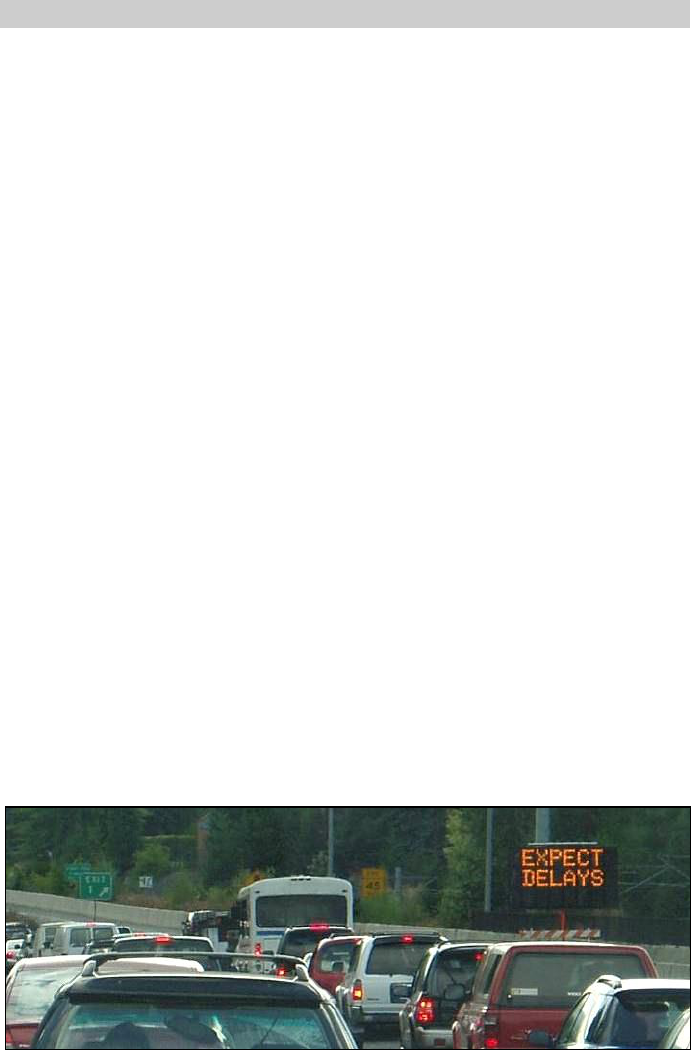
Oregon PCMS Handbook Page 13
September 2018 Messages
Credibility
Message credibility is an extremely important consideration in properly
operating a PCMS. Messages must provide timely, reliable, accurate, and
relevant information.
Messages should avoid using generic ‘signal’ words – DANGER,
WARNING, CAUTION, etc. Research [7] indicates these types of words
may not be interpreted as intended, and often do not affect motorist driving
patterns or behaviors.
Many factors reduce PCMS credibility [10], including information that is:
• Inaccurate – Messages do not reflect current roadway conditions
(e.g. warning of Flaggers ahead when no flagging work is being
conducted).
• Outdated – Poorly timed PCMS messages impair their effectiveness
(e.g. Ramp closure warnings for a ramp that reopened one week
ago).
• Irrelevant – Messages displayed on mainline for a distant side road
location (e.g. PCMS message displayed on a freeway for a local
street paving operation that makes no impact to freeway traffic).
• Repetitive – Displaying the same, generic message for 2 continuous
weeks or more in a high-traffic, urban area. Motorists will likely
begin to ignore the message, rendering the PCMS ineffective.
• Poorly Designed – Poorly structured, misspelled, overly-
abbreviated, slang messages result in confusion and ineffectiveness
(e.g. “TK NXT EXT 201A – RD CLOSD AHD”).
• Obvious – Displaying messages that describe a condition already
apparent to drivers (e.g. Displaying, “EXPECT DELAYS” to three
lanes of bumper-to-bumper traffic).
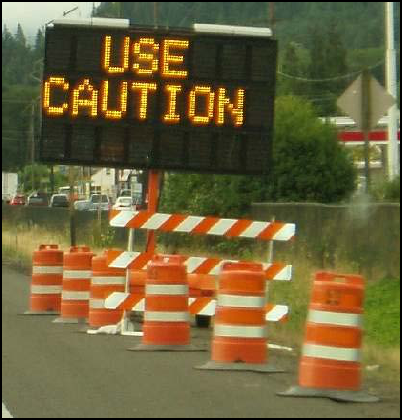
Oregon PCMS Handbook Page 14
September 2018 Messages
• Trivial – “USE CAUTION”, “SLOW”, even “ROAD WORK
AHEAD” on a PCMS quickly become ignored by drivers, forcing
PCMS to lose their effectiveness in changing driver behavior.
Avoid displaying overly simplistic messages that add little value to
other signs or devices used in the work zone. Provide drivers with
clear reasons for focusing their attention and changing their driving
behaviors as they enter and drive through the work zone – e.g.
“WORKERS IN ROAD” or “LANE NARROWS”.

Oregon PCMS Handbook Page 15
September 2018 Messages
Standard Messages
Motorists need more time to read unusual or complex messages – specific
road names, dates, times, etc. Being able to quickly read and process a
message results in faster driver response times. Standard messages should be
used wherever practical [7][10]. See Appendix A for a variety of Standard
Messages.
Non-Standard Messages
If the Standard Messages from Appendix A are not adequate for a given
condition or application, a custom message may be developed.
On state highways, if a custom, non-standard message is needed, the message
shall be approved by an ODOT Region Traffic Engineer/Manager, ODOT
Construction Project Manager, District Manager, or their representative,
where applicable.
Use the PCMS Message Worksheet in Appendix B to plan the message
[11]. Following approval, store the Message Worksheet with the PCMS.
Consider the following factors when creating a custom message:
1. Keep the message simple, brief, legible, and clear. An effective
message provides adequate information to drivers. Ineffective
messages result in frustration, confusion, even decreased safety.
Messages that are too short, vague or generic may cause drivers to:
• Drive in a manner different than intended
• Misinterpret the message
• Become confused, angry, frustrated, even violent
• Ignore the message completely
Too much information – overly complex, 3 or more phases, etc. – may
cause drivers to:
• Not be able to read entire message
• Become overly distracted by the message trying to read it all
• Ignore the message.
Keep messages concise. Motorists can only process a limited amount
of information in a given amount of time. Research [12] suggests the
maximum number of words in a message, including both phases,
should not exceed:
• 8 words on roads with a posted speed of 55 mph and less
• 7 words on freeways
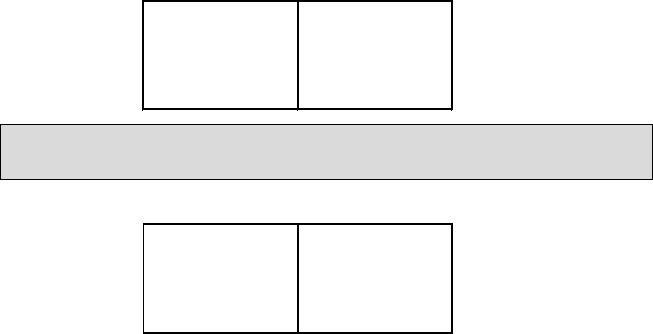
Oregon PCMS Handbook Page 16
September 2018 Messages
2. Messages should address the following items:
a. Problem – e.g. Left lane is closed, detour is ahead
b. Location – e.g. Lane closure in 1 mile, drivers use Exit 214 for
detour
c. Time – e.g. Closures occur Tuesday – Friday, 8 p.m. – 6 a.m.
d. Action – e.g. Drivers must exit and prepare to stop
The above list is generally in order of importance. Choose the most
important information to display – given the circumstances, message
size limit, and desired driver response.
Add an attention statement if the message is being directed at a specific
group of drivers or vehicle classification (e.g. Through-traffic; or, All
trucks).
In the example of an approaching low bridge, a problem statement is
needed, plus a height restriction announcement and the detour route(s).
A PCMS message might look like the following:
NOTE: If a height limit measurement includes 10” or 11”, the
message may be rounded down to 9” to save on character needs.
If the roadway is closed to all vehicles, the message may become:
3. Avoid using unnecessary words – articles of speech (a, an, the)
unless the intent of the message becomes unclear without them.
4. Avoid using abbreviations, when possible.
a. If necessary, follow guidance in the Standard Abbreviation
section below.
HT LIMIT
XXFT XIN
1 MILE
TRUCKS
DETOUR
NEXT RT
ROAD
CLOSED
1 MILE
DETOUR
NEXT
RIGHT

Oregon PCMS Handbook Page 17
September 2018 Messages
b. For abbreviations not listed, create an abbreviation using the
following techniques:
i. By removing one or more vowels – commonly near the
end of the word:
“EXIT” may become, “EXT”
“CANYON” may become, “CANYN”
“SEASIDE” may become, “SEASID” or “SEASD”
ii. If necessary, a combination of vowels and extra
consonants may be deleted:
“WILLAMETTE” might become, “WILLAMET”
iii. A combination of removing vowels and letters from the
end of a word until it is the desired length.
“OVERWEIGHT” may become, “OVRWEIGH”
Research [7] shows truncated abbreviations are easier to
recognize and comprehend than conventional or contracted
abbreviations.
Example: EMERGENCY: “EMERGENC” may be more
recognizable than, “EMERGNC” or, “EMRGNCY”
Example: SHOULDER: “SHOULDR” may be more
recognizable than, “SHLDR” or “SHLDER”
c. Do not use a period with abbreviations.
5. Messages should be made of meaningful pieces of information
understood as independent phases.
a. A single phase display is preferred.
b. Use a maximum of two phases for a given message.
c. Split message components where it makes the most sense.
AVOID
PREFERRED
d. Reduce the message length or complexity during heavy traffic
volumes, bad weather, or other demanding driving environments.
e. Use two signs for complex or longer messages.
TRUCKS
MUST
USE
DETOUR
1 MILE
AHEAD
TRUCKS
MUST USE
DETOUR
TRUCK
DETOUR
1 MILE

Oregon PCMS Handbook Page 18
September 2018 Messages
6. Do not display expected, unessential, or implied actions or
information [7]. For example:
a. Drivers will expect to have to merge right when they read:
Displaying, “TRAFFIC MERGE RIGHT” on the second panel
may be used; but, a description of the work activity, condition, or
hazard on the second phase may be more useful to drivers:
b.
“FOLLOW DETOUR” uses fewer words than, “FOLLOW
DETOUR ROUTE” to display the same critical information.
c. “FLAGGER AHEAD” is more critical than, “EXPECT
DELAYS”, and still implies potential delays.
LEFT
LANE
CLOSED
PAVING
NEXT
2 MILES

Oregon PCMS Handbook Page 19
September 2018 Messages
Message Exceptions
Under limited conditions, a message may be composed of three phases. The
following represent cases where a third phase may be displayed on a single
PCMS:
• Emergency situations
• Cases of inclement weather
• For regulatory snow zone messages
(See Appendix A: Snow and Ice – Regulatory Conditions)
(OAR 734-17-0015, OAR 734-17-0025)
• Locations with limited right of way precluding placement of a
second PCMS
• Lack of PCMS availability
• Other site restrictions or conditions, when approved by an ODOT
Region Traffic Engineer/Manager, ODOT Construction Project
Manager, District Manager, or their representative.
Sight distance to the PCMS should be maximized under these conditions to
provide drivers with the best chance of reading all three phases.
See Appendix A – Standard Messages for example messages that may
provide useful alternatives to using a third phase.
In some instances, a third phase may be needed to convey additional
information. If a third phase is needed, a second PCMS should be used.
If two PCMS are needed, set up both PCMS, program the three desired
phases and test the message sequence. Then, display the two PCMS to traffic,
as timely as practical.
If a second PCMS is added to provide additional information to an existing
operating PCMS, set up, program and test the second PCMS. Then, display
the second PCMS message to traffic.
If a second PCMS is used, the message on the additional PCMS does not
need to repeat any part of the first PCMS message. If two PCMS are
available, one static (unchanging) phase should be displayed on the first
PCMS. The second PCMS should be used to display the second and third
phases.
In choosing to use longer PCMS messages (including adding a second
PCMS), it should be noted that research indicates motorists have difficulty
comprehending long, complex messages, even when using two PCMS to
display the message [12].

Oregon PCMS Handbook Page 20
September 2018 Messages
Speeds
Speed messages on a PCMS should be limited to advisory or warning
messages. Speed messages should be used to supplement regulatory posted
speed signs, such as:
or
When displaying speed reduction messages [6]:
• Provide a reason drivers should slow down, such as:
or
• Do not display safety campaign messages on PCMS, such as,
“CLICK IT OR TICKET”, “DONT DRINK & DRIVE”, or other
public service messages.
• For extended work (i.e. 1 year or longer), use a PCMS during the
first week or two of the project, and after any major condition
changes. Use passive traffic controls at other times.
• Place the first PCMS 500 to 1000 feet upstream from the condition
or hazard. The PCMS may be placed before or after the initial
advance warning sign (e.g. ROAD WORK AHEAD), but should not
block this critical sign, nor have the PCMS messages blocked by it.
WORKZONE
SLOW TO
XX MPH
REDUCE
SPEED TO
XX MPH
XX MPH
SLOW FOR
WORKERS
SLOWED
TRAFFIC
AHEAD

Oregon PCMS Handbook Page 21
September 2018 Messages
Speed Detection Feature on PCMS
Speed detection devices can be fitted onto a PCMS and used to provide
vehicle speed information on the display. A PCMS used to display
instantaneous vehicle speeds can be used for a wide range of conditions –
roadside hazards, adverse weather conditions, traffic incidents, pavement
condition, heavy congestion, etc. [13]. A PCMS with this feature can
encourage speed limit compliance and reduce the speed of vehicles through a
work zone. Speed zone compliance is increased when a reason for the
reduced speed is displayed on the PCMS [14].
When displaying approach speeds:
• Display the PCMS in conjunction with a Speed Limit sign.
• Use the following message:
Consider the following before using a PCMS with speed detection capability:
• If used for more than 4 weeks, periodic police enforcement should be
arranged to reinforce and maintain the effectiveness of the PCMS.
• Check the radar each time the PCMS is set up. Calibrate and adjust,
as necessary, to ensure accuracy.
• The radar should be aimed to measure the speeds of vehicles
traveling in the fastest moving lane, at no more than 10 seconds of
distance upstream from the PCMS location.
• On roadways with posted speeds of 50 mph or greater, speeds of
vehicles traveling more than 25 mph over the speed limit should not
be displayed on the PCMS.
• In work zones, the first PCMS should be positioned 500 to 1000 feet
upstream of the hazard, so drivers have time to read and interpret the
message, and react before reaching the hazard.
YOUR
SPEED IS
XX MPH

Oregon PCMS Handbook Page 22
September 2018 Messages
Locations and Distances
Often times, using a specific distance to indicate an approaching condition or
hazard provides better information than the more generic, “AHEAD”. If
using distances in a message, use the following practices:
MILES
• For distances beyond 1/4 mile, it is more practical to use “MILES” to
describe the distance. Drivers struggle determining 1500, 2000 or
more feet – and will try to convert it to miles anyway.
• Fractions – 1/4 or 1/2 should be used.
• Distances in miles may be written as, “MILE” (singular), “MILES”,
or the abbreviation, “MI”
• Mile points (MP), while understood by truck drivers and law
enforcement agencies, may not be clear to public traffic. Therefore,
distances in miles to/from closure points, specific locations or other
landmarks should be used in messages instead of references to mile
points.
FEET
• Distances less than 1/4 mile should be shown in feet, and rounded to
the nearest 100 feet – e.g. “USE DETOUR 1000 FT”
• A distance in feet may be written as, “FEET” or abbreviated as, “FT”
• If using feet to describe smaller dimensions (e.g. lane widths), it is
most common to use the abbreviation, “FT”
• “11 FT / LANES / NEXT MI”, versus writing it out completely (e.g.
“11 FOOT / LANES / NEXT MI”).
Oregon PCMS Handbook Page 23
September 2018 Messages
EXITS
If Exit numbers or proper names for places are shown on existing guide signs
before a PCMS, or just beyond it, the Exit number or place name (e.g.
Medford, Crater Lake, Mt. Hood) should be used, when practical.
• Use Exit numbers on interstate highways for consistency and to meet
driver expectations.
• For multiple, consecutive exits less than 1 mile apart, or where
multiple “Exit XXX” signs can be seen in the same field of vision,
consider using, “NEXT EXIT”, “2ND EXIT”, etc. instead of
distances or Exit numbers.
• If displaying place names, try to use the same name as shown on
existing guide signs in the vicinity of the PCMS.
• Avoid using local nicknames or adjacent landmarks, unless the name
is shown elsewhere on other existing guide signs in the area.
• Unfamiliar motorists will have difficulty understanding local street
and highway names (e.g. ‘McLaughlin Blvd.’, ‘Sunset Hwy’, etc.),
and local landmarks or bridges (e.g. ‘The Waterfront’, ‘Marquam
Bridge’, etc.).

Oregon PCMS Handbook Page 24
September 2018 Messages
Times, Days and Dates
Research shows displaying time, day, and date information approaches driver
information processing limits [12][15]. Time, day and date messages should
be used sparingly.
Regardless of the format, over 25% of drivers viewing time/date information
will be unable to, or will incorrectly, determine if the work activity will
affect their trip.
If time, days, or dates are needed in a PCMS message, consider the
following:
• Do not display the Date, Day, and Time information across two-
phases.
DAYS
• For day ranges within the current week, or the following week, days
of the week may be displayed as:
- Monday: MON
- Friday: FRI
- Tuesday: TUE or TUES
- Saturday: SAT
- Wednesday: WED
- Sunday: SUN
- Thursday: THU, THUR, or THURS
• Day ranges may be displayed using a hyphen. “THRU” or
“THROUGH” is not necessary – e.g. “TUE-THUR”, “WED-SAT”.
• “NITE” may be used in place of, “NIGHT”.
• “WEEKEND” may be used if the event or condition begins on
Saturday morning and ends Sunday evening.
DATES
• Typically, only Month and Day are needed. Do not display the year
in the date, unless condition spans multiple years.
• For date ranges in the same month:
o Use three-letter month abbreviations – “APR”, “SEP”, “JAN”
o Use the Month only once in the message: “JUL 8-12”
• Avoid displaying the month as a number (e.g. April as, “4”), unless
the date range spans multiple months, and no other options are
available.
• If using numbers for Months, display without leading “0”. Example:
July 30-Aug 9 becomes, “7/30-8/9”
• Avoid using, “FOR 1 WEEK” or similar messages as the start and
end dates are ambiguous.

Oregon PCMS Handbook Page 25
September 2018 Messages
TIMES
• Use Time messages sparingly.
• Use standard 12-hour format for time, using “AM” and “PM”.
EXAMPLES
1. A road is being closed next week. The following might be posted
the weekend before and left in place until the end of the shift on
Friday:
2. If the closure is two weeks away, the message might read:
NOTE: “JUL12-14” with no space between “JUL” and “12-14” is
still legible on a PCMS due to the spacing between individual
characters on the message board and the mix of alpha and numeric
characters.
3. If the closure is within July and August, for a limited time, and
uses a detour, the message may read:
This PCMS would be used to supplement other temporary closure
and detour signing.
4. If the detour is in effect between 7am and 7pm, the message might
read:
MAIN ST
CLOSED
MON-FRI
MAIN ST
CLOSED
JUL12-14
MAIN ST
CLOSED
7/31-8/2
7/31-8/2
MAIN ST
DETOUR
MAIN ST
CLOSED
5AM-7PM
5AM-7PM
MAIN ST
DETOUR

Oregon PCMS Handbook Page 26
September 2018 Messages
Security
A high level of security should be exercised when operating a PCMS.
Authorized personnel are responsible for the messages displayed and for the
equipment itself.
Access to the control console and electronics must be controlled by
authorized personnel only. The control console shall include a locking lid
and remain locked when not being serviced by authorized personnel.
Password protection should be utilized to avoid unauthorized access to the
control panel. The password shall be changed from the factory default and
shall not be posted in the cabinet. Any tampering or vandalism should be
reported immediately to the authorities.
Standard Abbreviations
Due to limitations in the number of characters used in a line (8 characters) or
phase (3 lines) of a PCMS message, abbreviations may be necessary.
If abbreviating, use the abbreviations in Table 3 – Standard Abbreviations.
For additional abbreviations, see Section 1A.15 of the MUTCD.
If abbreviating word messages see Table 4 for a list of Prompt Words that
should precede or follow the abbreviation.
Do not use the abbreviations shown in Table 5 as they are commonly
misinterpreted by road users.
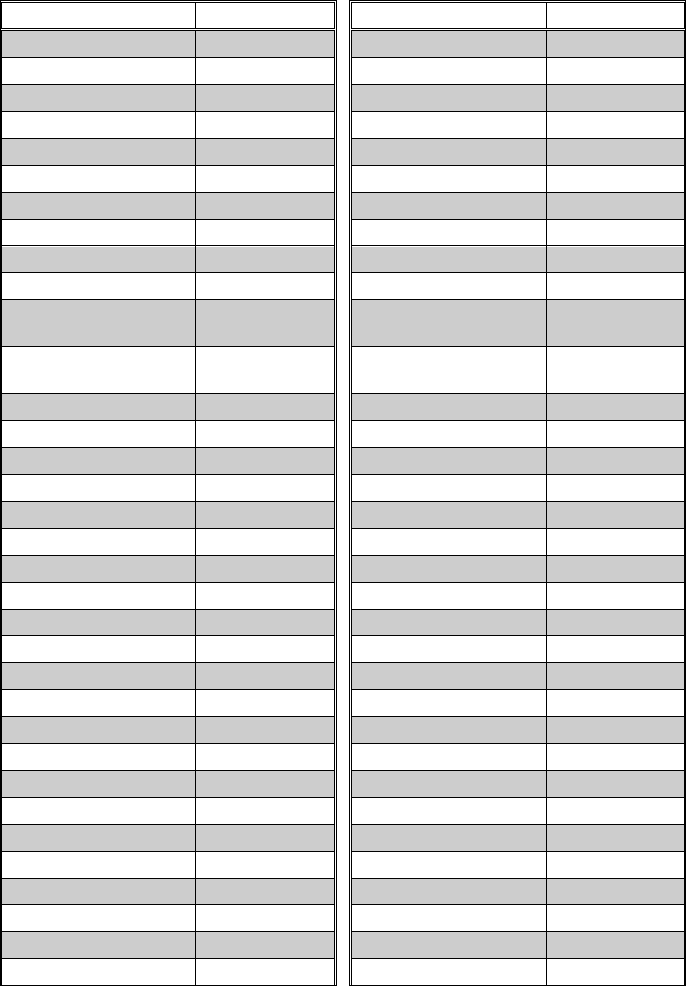
Oregon PCMS Handbook Page 27
September 2018 Messages
TABLE 3 – Standard Abbreviations
Word Message
Abbreviation
Word Message
Abbreviation
Access
ACCS
Monday
MON
Afternoon/Evening
PM
Morning/Late Night
AM
Alternate
ALT
Motorcycles
CYCLES
AM Radio
AM
North
N
Avenue
AVE, AV
Northbound
NB
Bicycle
BIKE
Parking
PKING
Boulevard
BLVD*
Parkway
PKWY*
Cannot
CANT
Pedestrian
PED
CB Radio
CB
Pounds
LBS
Circle
CIR*
Right
RT
Crossing (other than
highway-rail)
XING
Road RD*
Crossing (Hwy-Rail
Grade Crossing)
RR XING Saturday SAT
Do Not
DONT
Shoulder
SHLDR
East
E
Slippery
SLIP
Eastbound
EB
South
S
Emergency
EMER
Southbound
SB
Entrance, Enter
ENT
Speed
SPD
Expressway
EXPWY
Street
ST*
Feet
FT
Sunday
SUN
FM Radio
FM
Temporary
TEMP
Freeway
FRWY, FWY
Terrace
TER*
Friday
FRI
Thursday
THURS
Highway
HWY
Traffic
TRAF
Hour(s)
HR, HRS
Trail
TR*
Information
INFO
Travelers
TRVLRS
Junction/Intersection
JCT
Tuesday
TUES
Lane
LN
Two-Way Intersection
2-WAY
Left
LFT
2-Wheeled Vehicles
CYCLES
Maintenance
MAINT
Vehicle(s)
VEH, VEHS
Maximum
MAX
Warning
WARN
Mile(s)
MI
Wednesday
WED
Miles Per Hour
MPH
West
W
Minimum
MIN
Westbound
WB
Minutes
MINS
Will Not
WONT
* This abbreviation shall not be used without the formal name of a
roadway.

Oregon PCMS Handbook Page 28
September 2018 Messages
The abbreviations for the words listed in Table 4 should not be used unless
the prompt word listed in Table 4 either precedes or follows the abbreviation.
TABLE 4 – Acceptable Abbreviations with Prompt Word
Word Message
Abbreviation
Prompt Word
Ahead
AHD
Fog, Dust, Ice, Fire *
Blocked
BLKD
Lane, Road *
Bridge
BR
[Bridge Name]*
Center
CNTR
Lane**
Construction
CONST
Ahead**
County, or other non-US,
non-Interstate, or non-
Oregon numbered Route
[Abbreviation determined
by Roadway Agency]***
[Route Number] **
Downtown
DWNTN
Traffic, Event **
Frontage
FRNTG
Road**
Interstate
I-
[Route Number] **
Lane LN
[Roadway Name],
Right, Left, Center *
Oregon Numbered Route
OR
[OR Route Number] **
Oversized
OVRSZ
Load**
Right
RT
Keep, Next *
Right
RT
Lane**, Turn
Roadwork
RDWK
Ahead, [Distance] **
Route
RT, RTE
Best, Alt, Other*
US Numbered Route
US
[US Route Number] **
* Prompt Word should precede the abbreviation.
** Prompt Word should follow the abbreviation.
*** Use a space (no dash) between the abbreviation and the Route Number.
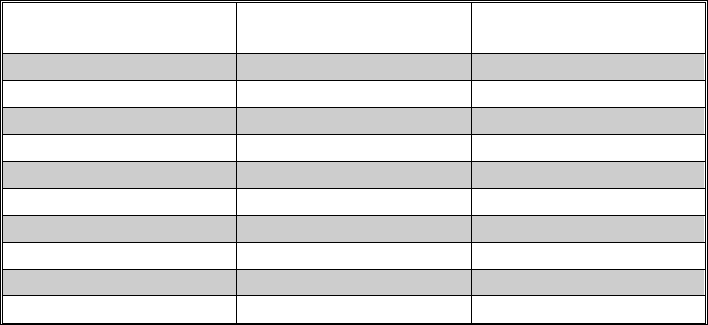
Oregon PCMS Handbook Page 29
September 2018 Messages
TABLE 5 – Unacceptable Abbreviations
Abbreviation Intended Word
Common
Misinterpretation
ACC
Accident
Access (Road)
CLRS
Clears
Colors
DLY
Delay
Daily
FDR
Feeder
Federal
L
Left
Lane (Merge)
LT
Light (Traffic)
Left
PARK
Parking
Park
POLL
Pollution (Index)
Poll
RED
Reduce
Red
WRNG
Warning
Wrong
Oregon PCMS Handbook Page 30
September 2018 References
REFERENCES
[1]
Federal Highway Administration, Manual on Uniform Traffic Control
Devices for Streets and Highways, 2009 ed., Washington, D.C., 2009.
[2]
Oregon Department of Transportation, Oregon Standard Specifications
for
Construction, 2018 ed., Salem, Oregon: Oregon Department of
Transportation, 2018
. [Online]. Available:
https://www.oregon.gov/ODOT/Business/Documents/2018_STANDAR
D_
SPECIFICATIONS.pdf. [Accessed 28 August 2018].
[3]
Oregon Department of Transportation, "Oregon Temporary Traffic
Control Handbook for Operations of Three Days or Less,"
September
2016
. [Online]. Available:
https://www.oregon.gov/ODOT/Engineering/Docs_TrafficEng/OTTCH
-
v2011.pdf
. [Accessed 28 August 2018].
[4]
Federal Highway Administration, "Portable Changeable Message Sign
Handbook," 2003. [Online]. Available:
http
s
://www.fhwa.dot.gov/publications/research/infrastructure/pavements/
ltpp/reports/03066/
. [Accessed 28 August 2018].
[5]
G. L. Ullman, C. L. Dudek and B. R. Ullman, "Development of a Field
Guide for Portable Changeable Message Sign Use in Work Zones," Texas
Department of Transportation, College Station, Texas, 2005.
[6]
J. L. Campbell, C. M. Richard, J. L. Brown, M. G. Lichty, J. Graham and
M. O'La
ughlin, "NCHRP Report 600: Human Factors Guidelines for
Road Systems: Collection C: Chapter 19," 2008. [Online]. Available:
http://onlinepubs.trb.org/onlinepubs/nchrp/nchrp_rp
t_600C.pdf.
[Accessed 13 July
2012].
[7]
D. R. Proffitt and M. M. Wade, "Creating Effective Variable Message
Signs: Human Factors Issues," Virginia Transportation Research Council,
Charlottesville, Virginia, 1998.
[8]
C. L. Dudek and G. L. Ullman, "Flashing Messages, Flashing Lines, and
Alternating One Line on Changeable Message Signs,"
Transportation
Research Record: Journal of the Transportation Research Board,
vol.
1803, pp. 94
-101, 2002.
[9]
C. L. Dudek, S. D. Schrock and G. L. Ullman, "Impacts of Using
Dynamic Features to Display Messages on Changeable Message Signs,"
Federal Highway Administration, Washington, D.C., 2005.
[10]
C. L. Dudek, "Changeable Message Sign Operation and Messaging
Handbook," Federal Highway
Administration, Washington, D.C., 2004.
Oregon PCMS Handbook Page 31
September 2018 References
[11]
Florida Department of Transportation, "Plans Preparation Manual," 1
January 2009. [Online]. Available:
http://www.dot.state.fl.us
/rddesign/PPMManual/2012/Volume1/.
[Accessed 27 August 2012].
[12]
J. L. Campbell and C. M. Richard, "NCHRP Report 600: Human
Factors Guidelines for Road Systems: Collection A: Chapter 13," 2008.
[Online]. Available:
http://onlinepubs.trb.org/onlinepubs/nchrp/nchrp_rpt_600A.pdf.
[Accessed 14 August 2012].
[13]
Maryland State Highway Administration, "Use of Portable Changeable
Message Signs with Speed Display in Work Zones,"
Maryland State
Highway Administration, Baltimore, Maryland, 2005.
[14]
J. L. Campbell, M. G. Lichty, J. L. Brown, C. M. Richard, J. S. Graving,
J. Graham, M. O'Laughlin, D. Torbic and D. Harwood, "NCHRP Report
600: Human Factors Guidelines for Road System
s," 2012. [Online].
Available:
http://onlinepubs.trb.org/onlinepubs/nchrp/nchrp_rpt_600Second.pdf.
[Accessed 23 October 2012].
[15]
G. L. Ullman, B. R. Ullman, C. L. Dudek, A. Williams and G. Pesti,
"Advance Notification Messages and Use of Sequential Portable
Changeable Message Signs in Work Zones," Texas Department of
Transportation, Austin, Texas, 2005.
[16]
American Association of State Highway and Transportation Officials,
Highway Safety Manual, 1st ed., Washington, D.C.: AASHTO, 2010.
Oregon PCMS Handbook Page 32
September 2018 Appendix A – Standardized Messages
APPENDIX A – STANDARDIZED MESSAGES
The following list of standardized messages may be used for a variety of
temporary work zone activities, maintenance operations, traffic incidents,
weather conditions, or special events. The list of messages below is not all-
inclusive. Messages shown are meant as examples of possible phases and
combinations of phases used to develop a complete, informational, and
valuable PCMS message.
Message Details
• For the message examples below, one or two phases may be used in
developing the PCMS message. Phases from different examples may
be combined to meet specific needs.
• If using only one phase for the message, DO NOT FLASH the
message.
• For special events or specific activities, custom PCMS messages
should be created using the guidelines in this document.
• The “/” (slashes) in each message indicates the separation between
lines on the phase, and are not part of the message.
• Center each line of the message on the panel.
Programming Messages
• Each line can have up to 8 characters.
• For conditions in the right, left, or center lane, only one location is
shown. Use RIGHT, LEFT, CENTER or the appropriate
abbreviation, as needed.
• “XXX” is commonly used to signify numbers that must be filled in
at the time of placement and use.
• If an Exit number (XXX) is known, the message, “USE / EXIT /
XXX” may be substituted for, “USE / NEXT / EXIT” – especially if
the PCMS is placed more than 2 miles from the exit.
• For posted speeds 45 MPH or higher, minimize wording to promote
faster read/response times for drivers.
• Avoid using abbreviations. If necessary, use only those in Table 3 or
Table 4.
• Periods are not needed for abbreviations.

Oregon PCMS Handbook Page 33
September 2018 Appendix A – Standardized Messages
Message Categories
• Advance Notification
• Detours and Road Closures
• Flagging and Signals
• Dust, Fog, Fire and Smoke
• Bridge and Tunnel Work
• Shoulder and Median Work
• Road Surface Conditions
• Trucks
• Slow Moving Operations
• Motorcycles
• Rolling Slowdown Operations
• Snow and Ice – Warnings
• Snow and Ice –
Regulatory Conditions
• Lane Closures, Traffic Pattern
Changes
• Crash, Stalled Vehicle or
Other Incident
• Other General Warnings
Advance Notification
#
Phase 1
Phase 2
0100 WORKERS / IN ROAD / X MILE(S)
SLOW FOR / WORKERS / IN
ROAD
0101
WORKERS / AHEAD / SLOW
WORKZONE / SLOW TO / XX
MPH
0102
WORKERS / AHEAD IN / LFT
LANE
SLOWDOWN / IN / WORKZONE
0103
REDUCE / SPEED IN /
WORKZONE
WORKERS / X MILE(S) / AHEAD
0104
PAVING / NEXT / X MILE(S)
CAUTION / WORKERS / ON
RIGHT
0105
OR XXX / CLOSED / JUL15-18 TO COAST / USE / OR XXX
0106
ROADWORK / MON-THUR /
NIGHTS
MON-THUR / DETOUR / 9PM-
6AM
0107 NIGHT / LANE / CLOSURES EXPECT / DELAYS / XPM-XAM
0108
2 LANES / CLOSED / MON-THUR EXPECT / DELAYS / XPM-XAM
0109 ROADWORK / PAST / OR XXX THRU / TRAFFIC / USE I-XX
0110 USE / DETOUR / THUR-SUN
THUR-SUN / BAKER RD /
CLOSED

Oregon PCMS Handbook Page 34
September 2018 Appendix A – Standardized Messages
Detours and Road Closures
#
Phase 1
Phase 2
0200
DETOUR / AHEAD / X MILE(S) FOLLOW / DETOUR / SIGNS
0201
DETOUR / NEXT / LEFT FOLLOW / SIGNS / TO ORXXX
0202
DETOUR / AHEAD / 1000 FT USE / EXIT XXX / TO ORXXX
0203
DETOUR / X MILE(S) / AHEAD FOLLOW / DETOUR / TO I-XXX
0204
FREEWAY / BLOCKED / AHEAD PREPARE / TO / STOP
0205
FREEWAY / CLOSED / AHEAD ALL VEH / MUST / EXIT
0206
FREEWAY / CLOSED / 2 MILES USE / NEXT / EXIT
0207
I-XXX / CLOSED / AT EX(XXX) DETOUR / USING / HWY XXX
0208
RAMP / CLOSED / XX MILES DETOUR / NEXT / EXIT
0209
ROAD / CLOSED / AHEAD LOCAL / TRAFFIC / ONLY
0210
ROAD / CLOSED / X MILE(S) USE / DETOUR
0211
ROAD / CLOSED / AT MP XX USE / CANYN RD / DETOUR
0212
ROAD / NARROWS / AHEAD LANES / NARROW / 1/2 MILE
0213
ROADWORK / NEAR /
DOWNTOWN
THRU / TRAF USE / I-XXX
0214
US XXX / CLOSED / XX MILES US XXX / DETOUR / EXIT XX
0215
USE / DETOUR / ROUTE FOLLOW / DETOUR / SIGNS
0216
USE / DETOUR / AHEAD TURN / NEXT / RIGHT
0217
DETOUR / USE / I-XXX TURN / RIGHT / 1/4 MILE

Oregon PCMS Handbook Page 35
September 2018 Appendix A – Standardized Messages
Flagging and Traffic Signals
#
Phase 1
Phase 2
0300
24 HOUR / FLAGGING / AHEAD PREPARE / TO / STOP
0301
FLAGGER / AHEAD PREPARE / TO / STOP
0302
FLAGGER / AHEAD / 1 MILE BE / PREPARED / TO STOP
0303
PILOT / CAR / 1 MILE BE / PREPARED / TO STOP
0304
PILOT / CAR / AHEAD PREPARE / TO STOP / 1/2 MILE
0305
SIGNAL / AHEAD / 1/2 MILE PREPARE / TO STOP
0306
TRAFFIC / SIGNAL / OUT ALL-WAY / STOP / AHEAD
0307
SIGNAL / OUT YIELD / RIGHT / OF WAY
0308
SIGNAL / WORK / AHEAD PREPARE / TO / STOP
0309
SIGNAL / WORK / 1/2 MILE LEFT / TURN LN / CLOSED
0310
SIGNAL / WORK / AHEAD USE / RIGHT / LANE
0311
SIGNAL / OUT / AHEAD FLAGGERS / IN / ROAD

Oregon PCMS Handbook Page 36
September 2018 Appendix A – Standardized Messages
Lane Closures or Traffic Pattern Changes
#
Phase 1
Phase 2
0400
CROSS / TRAFFIC / AHEAD
YIELD TO / CROSS / TRAFFIC
0401
DO / NOT / PASS
STAY / IN / LANE
0402
DO NOT / STOP ON / SHOULDER
NO / SHOULDER / PARKING
0403
EXIT (XXX) / CLOSED / AHEAD
USE / NEXT (THIS, SECOND) /
EXIT
0404
HEAVY / TRAFFIC / AHEAD
PREPARE / TO / SLOW
0405
HEAVY / TRAFFIC / AHEAD
PREPARE / TO / STOP
0406
LFT LANE / ENDS / 1/2 MILE
SLOWED / TRAFFIC / AHEAD
0407
RT LANE / NARROWS / 1000 FT SLOWED / TRAFFIC / AHEAD
0408
LANES / SHIFT / TO LEFT STAY / IN (YOUR) / LANE
0409
LEFT / 2 LANES / CLOSED
MERGE / INTO (WITH) /
RT LANE
0410
LEFT / LANE / CLOSED
RT LANE / FOR ALL / TURNS
0411
LEFT / LANE / NARROWS
TRUCKS / USE / RT LANE
0412
NARROW / LFT LANE / AHEAD TRUCKS / RT LANE / ONLY
0413
LEFT LN / CLOSED / 1000 FT
RT LANE / SLOWED / AHEAD
0414
LEFT LN / CLOSED / AHEAD EXPECT / SLOWED / TRAFFIC
0415
LEFT LN / CLOSED / 1(/2) MILE
PREPARE / TO MERGE / RIGHT
0416
MERGING / TRAFFIC / AHEAD TRAFFIC / ENTERS / ON RIGHT
0417
MERGE / INTO LFT / LANE(S) RT LANE / MUST / TURN RT
0418
MERGE / RIGHT
LFT LANE / TURN LFT / ONLY
0419
RT LANE / CLOSED / X MILE(S) NO RIGHT / TURN / AHEAD
0420
SHARP / CURVE / AHEAD
CURVE / SLOW TO / XX MPH
0421
SLOW / TRAFFIC / AHEAD
PREPARE / TO / SLOW
0422
STAY / IN / LANE
NO / LANE / CHANGES
0423
TRAFFIC / CONTROL / CHANGE
YIELD / AHEAD
0424
TRAFFIC / CONTROL / CHANGE STOP / AHEAD
0425
TRAFFIC / CONTROL / CHANGE
SIGNAL / AHEAD
0426
TRAFFIC / DELAYS
PREPARE / TO / SLOW
0427
TRAFFIC / DELAYS PREPARE / TO / STOP
0428
TWO-WAY / TRAFFIC / AHEAD
DO / NOT / PASS
0429
YIELD / AHEAD YIELD / TO / ONCOMING

Oregon PCMS Handbook Page 37
September 2018 Appendix A – Standardized Messages
Bridge or Tunnel Work
#
Phase 1
Phase 2
0500
CROSS / TRAFFIC / AHEAD
YIELD TO / CROSS / TRAFFIC
0501
DO / NOT / PASS
STAY / IN / LANE
0502
DO NOT / STOP ON /
SHOULDER
NO / SHOULDER / PARKING
0503
EXIT (XXX) / CLOSED / AHEAD
USE / NEXT (THIS, SECOND) /
EXIT
0504
HEAVY / TRAFFIC / AHEAD
PREPARE / TO / SLOW
0505
HEAVY / TRAFFIC / AHEAD PREPARE / TO / STOP
0506
LFT LANE / ENDS / 1/2 MILE
SLOWED / TRAFFIC / AHEAD
0507
RT LANE / NARROWS / 1000 FT
SLOWED / TRAFFIC / AHEAD
0508
LANES / SHIFT / TO LEFT STAY / IN (YOUR) / LANE
0509
LEFT / 2 LANES / CLOSED
MERGE / INTO (WITH) /
RT LANE
0510
LEFT / LANE / CLOSED RT LANE / FOR ALL / TURNS
0511
LEFT / LANE / NARROWS
TRUCKS / USE / RT LANE
0512
NARROW / LFT LANE / AHEAD TRUCKS / RT LANE / ONLY
0513
LEFT LN / CLOSED / 1000 FT
RT LANE / SLOWED / AHEAD
0514
LEFT LN / CLOSED / AHEAD EXPECT / SLOWED / TRAFFIC
0515
LEFT LN / CLOSED / 1(/2) MILE
PREPARE / TO MERGE / RIGHT
0516
MERGING / TRAFFIC / AHEAD
TRAFFIC / ENTERS / ON RIGHT
0517
MERGE / INTO LFT / LANE(S) RT LANE / MUST / TURN RT
0518
MERGE / RIGHT
LFT LANE / TURN LFT / ONLY
0519
RT LANE / CLOSED / X MILE(S)
NO RIGHT / TURN / AHEAD
0520
SHARP / CURVE / AHEAD
CURVE / SLOW TO / XX MPH
0521
SLOW / TRAFFIC / AHEAD
PREPARE / TO / SLOW
0522
STAY / IN / LANE NO / LANE / CHANGES
0523
TRAFFIC / CONTROL / CHANGE
YIELD / AHEAD
0524
TRAFFIC / CONTROL / CHANGE
STOP / AHEAD
0525
TRAFFIC / CONTROL / CHANGE
SIGNAL / AHEAD
0526
TRAFFIC / DELAYS
PREPARE / TO / SLOW
0527
TRAFFIC / DELAYS PREPARE / TO / STOP
0528
TWO-WAY / TRAFFIC / AHEAD
DO / NOT / PASS
0521
YIELD / AHEAD YIELD / TO / ONCOMING

Oregon PCMS Handbook Page 38
September 2018 Appendix A – Standardized Messages
Shoulder or Median Work
#
Phase 1
Phase 2
0600
MEDIAN / WORK / KEEP RT WORKERS / IN / MEDIAN
0601
MEDIAN / WORK / AHEAD USE / RIGHT / LANE
0602
LEFT (RIGHT) / SHOULDER /
WORK
CLOSED / SHOULDER / X
MILE(S)
0603
LEFT (RIGHT) / SHOULDER /
WORK
WORKERS / ON / SHOULDER
0604
SHOULDER / WORK / AHEAD YIELD TO / WORKERS / ON LEFT
0605
SHOULDER / WORK / AHEAD USE / LEFT / LANE
0606
SHOULDER / WORK / AHEAD
WORKERS / IN LEFT /
SHOULDER

Oregon PCMS Handbook Page 39
September 2018 Appendix A – Standardized Messages
Road Surface Conditions (Rough, debris, oil, fresh paint, etc.)
#
Phase 1
Phase 2
0700
ABRUPT / EDGE / RIGHT
0701
ACTIVE / SLIDES / AHEAD REDUCE / SPEED
0702
DEBRIS / ON / ROAD KEEP / LEFT
0703
DEBRIS / ON / ROAD RIGHT / LANE / CLOSED
0704
DEBRIS / ON / ROAD PREPARE / TO / STOP
0705
DEBRIS / ON / ROAD EXPECT / DELAYS
0706
FRESH / OIL / ON ROAD
0707
NO / CENTER / STRIPE KEEP / RIGHT
0708
NO / LANE / LINES
0709
NO / LANE / LINES KEEP RT / EXCEPT / TO PASS
0710
NO / SHOULDER DO / NOT / STOP
0711
ROAD / FLOODED / 1/2 MILE
0712
ROCKS / ON / ROADWAY
0713
ROUGH / PAVEMENT / AHEAD PREPARE / TO / SLOW
0714
ROUGH / ROAD / AHEAD
0715
ROUGH / ROAD / AHEAD DIP / AHEAD / 1/2 MILE
0716
SLIDE / BLOCKS / ROAD PREPARE / TO / STOP
0717
SLIDE / ON / ROAD KEEP / RIGHT
0718
SOFT / SHOULDER
0719
WATER / ACROSS / ROAD
0720
WET / PAINT STAY / IN / LANE
0721
WET / PAINT PASS TO / LEFT

Oregon PCMS Handbook Page 40
September 2018 Appendix A – Standardized Messages
Trucks
#
Phase 1
Phase 2
0800
ALL / TRUCKS / EXIT EXIT / ALL / TRUCKS
0801
ALL / TRUCKS / KEEP RT TRUCKS / KEEP / RIGHT
0802
TRUCKS / USE / LOW GEAR STEEP / DOWNHILL / X MILE(S)
0803
ESCAPE / RAMP / CLOSED NEXT / ESCAPE / X MILE(S)
0804
OVERSIZE / MUST / EXIT OVERSIZE / EXIT / X MILE(S)
0805
OVERSIZE / USE NEXT / EXIT OVERSIZE / VEH EXIT / AHEAD
0806
STEEP / GRADE / AHEAD TRUCKS / SLOW / DOWN
0807
ALL / TRUCKS / EXIT EXIT / ALL / TRUCKS
0808
TRUCKS / OVER 80K / EXIT TRUCKS / EXIT / ON RIGHT
0809
OVER 80K / TRUCKS / EXIT TRUCKS / USE / RT LANE
0810
TRUCKS / XING / ROAD WATCH / FOR XING / TRUCKS
0811
CAUTION / TRUCKS / ON RIGHT TRUCKS / ENTERING / RIGHT
0812
XXFT XIN* / HT LIMIT/ 1 MILE
TRUCKS / DETOUR / NEXT RT
0813
EXIT XX / XX TON / LIMIT OVER WT / DETOUR / EXIT XX
Slow Moving Operations
#
Phase 1
Phase 2
0900
MOWERS / IN / MEDIAN WORK IN / MEDIAN / AHEAD
0901
MOWERS / IN / MEDIAN MOWING / NEXT / X MILE(S)
0902
SLOW / MOVING / WORK PREPARE / TO / SLOW
0903
SLOW / MOVING / WORK LEFT / LANE / CLOSED
0904
SLOW / MOVING / WORK KEEP / RIGHT
0905
SLOW / MOVING / WORK (RIGHT) / SHOULDER / CLOSED
0906
SLOW / MOVING / WORK
MEDIAN / (SHOULDER) /
CLOSED
0907
STRIPING / TRUCKS / AHEAD CENTER / LANE / CLOSED
0908
STRIPING / CENTER / LANE KEEP / RIGHT
0909
STRIPING / RIGHT / FOG LINE USE / LEFT / LANE
0910
SWEEPER / AHEAD USE / CAUTION
0911
SWEEPER / AHEAD USE / LEFT / LANE

Oregon PCMS Handbook Page 41
September 2018 Appendix A – Standardized Messages
Motorcycles
#
Phase 1
Phase 2
1000
BUMP / AHEAD CYCLES / STAY / IN LANE
1001
ROUGH / PAVEMENT / AHEAD CYCLES / NO LANE / CHANGES
1002
ROUGH / PAVEMENT CYCLES / USE CARE
1003
GROOVED / PAVEMENT /
NEXT XMI
CYCLES / KEEP / RIGHT (LEFT)
Rolling Slowdowns
#
Phase 1
Phase 2
1100
SLOWED / TRAFFIC / AHEAD XX MPH / NEXT / XX MILES
1101
XX MPH / TRAFFIC / AHEAD XX MPH / NEXT / XX MILES
1102
SLOW / VEHICLES DO / NOT / PASS
1103
SLOWED / TRAFFIC DO NOT / PASS
Snow and Ice – Warnings
#
Phase 1
Phase 2
1200
BLACK / ICE / LIKELY ROAD / MAY BE / SLIPPERY
1201
BLOWING / SNOW / AHEAD NEXT / X MILE(S)
1202
BLOWING / SNOW / AHEAD TURN ON / LIGHTS
1203
ICE / ON / BRIDGE(S) BRIDGE(S) / MAY / BE ICY
1204
ICE / ON ROAD / AHEAD ROAD ICY / NEXT / XX MILE(S)
1205
SNOW / BLOWERS / AHEAD DO NOT / PASS / ON RIGHT
1206
SNOW / BLOWERS / AHEAD DO / NOT / PASS
1207
SNOW / PLOWS / AHEAD USE / LEFT (RIGHT) / LANE
1208
SNOW / PLOW / AHEAD
DO NOT / PASS / ON RIGHT
(LEFT)
1209
WATCH / FOR / ICE ICY / NEXT / XX MILE(S)

Oregon PCMS Handbook Page 42
September 2018 Appendix A – Standardized Messages
Snow and Ice – Regulatory Conditions
#
Phase 1
Phase 2
Phase 3
1250
CARRY / CHAINS
OR / TRACTION /
TIRES
1251
SNOW / ZONE
CHAINS / REQUIRED
/ ALL VEH
1252
SNOW / ZONE CARRY / CHAINS
OR / TRACTION /
TIRES
1253
SNOW / ZONE
CHAINS / REQ’D ON /
VEHICLES
TOWING / OR OVER /
10000
1254
SNOW / ZONE
CHAINS / REQ’D ON /
VEHICLES
TOWING / OR OVER /
10K GVW
1255
SNOW / ZONE
CHAINS / REQ WHEN
/ TOWING
OR SINGL / AXLE
OVR / 10000
1256
CHAINS / REQ WHEN
/ TOWING
OR / SINGLE / DRIVE OVER / 10000 / GVW
1257
SNOW / ZONE CHAINS / REQUIRED
UND 10K / TRACTION
/TIRES OK
1258
CHAINS / REQUIRED
TRACTION / TIRES /
ALLOWED
VEHICLES / UNDER /
10K GVW
* Messages shown above are based on messages in OAR 734-017-0025
intended for use on permanent signs or variable message signs (VMS).
** For regulatory snow and ice conditions, a third phase may be added.

Oregon PCMS Handbook Page 43
September 2018 Appendix A – Standardized Messages
Dust, Fog, Fire, or Smoke
#
Phase 1
Phase 2
1300
BLOWING / DUST / AHEAD NEXT / X MILE(S)
1301
BLOWING / DUST / AHEAD TURN ON / LIGHTS
1302
DENSE / FOG / AHEAD TURN ON / LIGHTS
1303
DENSE / FOG / AHEAD REDUCED VISION
1304
FREEZING / FOG / AHEAD TURN ON / LIGHTS
1305
FREEZING / FOG / LIKELY IF FOGGY / ROAD MAY / BE ICY
1306
BURN / AREA / AHEAD SLOW / TURN ON / LIGHTS
1307
DENSE / SMOKE / AHEAD STOP ON / SHOULDER / ONLY
1308
DENSE / SMOKE / AHEAD SLOW / TURN ON / LIGHTS
1309
DENSE / SMOKE / AHEAD PREPARE / TO / SLOW (STOP)
1310
FIRE / AHEAD PREPARE / TO / SLOW (STOP)
1311
FIRE / AHEAD STOP ON / SHOULDER / ONLY

Oregon PCMS Handbook Page 44
September 2018 Appendix A – Standardized Messages
Crash, Stalled Vehicle, or Other Incidents
#
Phase 1
Phase 2
1400
WRECK / AHEAD CENTER / LANE / CLOSED
1401
TRAFFIC / CRASH / AHEAD EXPECT / DELAYS
1402
WRECK / AHEAD LEFT / LANE / CLOSED
1403
TRAFFIC / CRASH / AHEAD LEFT / 2 LANES / BLOCKED
1404
WRECK / AHEAD PREPARE / TO / STOP
1405
CRASH / AHEAD / LFT LANE USE / RIGHT / 2 LANES
1406
CRASH / RT LANE / 1 MILE MERGE / LEFT
1407
STALLED / VEHICLE PREPARE / TO / SLOW
1408
STALLED / VEHICLE / AHEAD SHOULDER CLOSED
1409
STALLED / VEHICLE / 1/2 MILE RIGHT / LANE / CLOSED
1410
STALLED / VEHICLE / ON RAMP TRAFFIC / ON RAMP / KEEP LFT
1411
DEBRIS / IN ROAD / KEEP RT KEEP RT / WORKERS / IN LANE
1412
YIELD TO / EMERGNCY /
WORKERS
CRASH / IN LEFT / LANE
1413
YIELD TO / EMERGNCY / CREWS RESCUE / WORKERS / AHEAD
1414
MOVE LFT / FOR FIRE /
FIGHTERS
CRASH / AHEAD / ON RIGHT

Oregon PCMS Handbook Page 45
September 2018 Appendix A – Standardized Messages
Other General Warnings
#
Phase 1
Phase 2
1500
CHILDREN / XING / HIGHWAY CHILDREN / XXX FT / AHEAD
1501
CHILDREN / X/X MILE / AHEAD WATCH / FOR / CHILDREN
1502
HEAVY / MERGING / TRAFFIC THRU / TRAFFIC / LFT LANE
1503
BICYCLES / IN LANE / AHEAD SHARE / THE / ROAD
1504
STOP / AHEAD / 1/2 MILE PEDSTRN / EVENT / AHEAD
1505
TRAFFIC / ADVISORY /
XXX.X AM
XXX.X AM / FOR ROAD / INFO
1506
BICYCLE / EVENT / NEXT XMI WATCH / FOR / BICYCLES
1507
TRAFFIC / SLOW AT / STADIUM STADIUM / EVENT / APR 30
1508
SLOW FOR / EXPO CTR /
TRAFFIC
EXPO CTR / EVENT / SATURDAY
1509
FAIRGRND / TRAFFIC / AHEAD THRU / TRAFFIC / USE ALT
1510
CO FAIR / TRAFFIC / KEEP LFT THRU / TRAFFIC / RT LANE

Oregon PCMS Handbook Page 46
September 2018 PCMS Message Worksheet
APPENDIX B – SETUP CHECKLIST
Need
Could a static sign be used to send the same message?
Is the static sign readily available?
Placement
Is the PCMS visible from at least ½ mile away?
Can the message be read from at least 800 feet away during the day?
At least 600 feet away during the night?
If two PCMS are used, they are separated by at least 1000 feet and on
the same side of the road?
Message
Is each phase understandable by itself?
Does the PCMS Message give drivers new information or add
clarity?
Does the PCMS warn the motorist of a problem ahead?
Have standard abbreviations been used?
Are there no more than 2 phases on each PCMS?
Is each phase displayed for at least 2 seconds?
Is the total display time for both phases less than 8 seconds?
Is the message free of animation (scrolling or flashing)?
Are correct lanes, highways, exit numbers, days, dates, and/or times
displayed?
Are messages, display characteristics, and dates and times of display
documented in the project diary?
When work is to begin within seven days, replace calendar dates
(e.g. MAY 25-27) with days of the week (e.g. TUE-THUR).
Turn PCMS off and rotate display away from traffic when not in use.

Oregon PCMS Handbook Page 47
September 2018 PCMS Message Worksheet
PCMS MESSAGE WORKSHEET
LOCATION:
USED: From: / / at : am/pm
To: / / at : am/pm
Message Programed By:
PHASE 1
PHASE 1 will run for sec. (2.0 sec minimum)
PHASE 2
PHASE 2 will run for sec. (2.0 sec. minimum)
Total Display Time = sec. (8.0 sec. maximum)
(Total Display Time includes two blank times between Phases)
